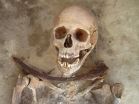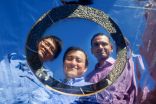Post-medieval Polish buried as potential 'vampires' were likely local
Potential vampires in the 17th-18th century buried with rocks, sickles to ward off evil
2014-11-26
(Press-News.org) Potential 'vampires' buried in northwestern Poland with sickles and rocks across their bodies were likely local and not immigrants to the region, according to a study published November 26, 2014 in the open-access journal PLOS ONE by Lesley Gregoricka from University of South Alabama and colleagues.
In northwestern Poland, apotropaic funerary rites--a traditional practice intended to prevent evil--occurred throughout the 17th-18th c. AD. Those of the dead considered at risk for becoming vampires for a variety of reasons were given specific treatment, and investigating these burial practices may provide insight into community cultural and social practices, as well as the social identities of people living in the area at the time. Excavations at a cemetery in northwestern Poland have revealed six unusual graves, with sickles across the bodies or large rocks under the chins of select individuals, amidst hundreds of normal burials. To better understand whether the bodies selected for apotropaic burial rites were local or non-local immigrants, the authors of this study tested permanent molars from 60 individuals, including 6 "special" or deviant burials, using radiogenic strontium isotope ratios from archaeological dental enamel. They then compared the results to strontium isotopes of local animals.
The authors found that those in deviant burials seem to be a predominantly local population, with all individuals buried as potential vampires exhibiting local strontium isotope ratios. These data indicate that those targeted for apotropaic practices were not likely migrants to the region, but instead, local individuals whose social identity or manner of death likely marked them with suspicion in some other way. The authors suggest one alternate explanation behind these apotropaic burials may be the cholera epidemics that were prevalent in Eastern Europe during the 17th century, as the first person to die from an infectious disease outbreak was presumed more likely to return from the dead as a vampire. "People of the post-medieval period did not understand how disease was spread, and rather than a scientific explanation for these epidemics, cholera and the deaths that resulted from it were explained by the supernatural - in this case, vampires," said Dr. Gregoricka.
INFORMATION:
In your coverage please use this URL to provide access to the freely available paper: http://dx.plos.org/10.1371/journal.pone.0113564
Citation: Gregoricka LA, Betsinger TK, Scott AB, Polcyn M (2014) Apotropaic Practices and the Undead: A Biogeochemical Assessment of Deviant Burials in Post-Medieval Poland. PLoS ONE 9(11):e113564. doi:10.1371/journal.pone.0113564
Funding: This research was supported by a University of South Alabama (USA) Faculty Development Council Grant, USA Arts & Sciences Support and Development Award, USA Arts & Sciences Summer Professional Development Award, and the Slavia Project. The funders had no role in study design, data collection and analysis, decision to publish, or preparation of the manuscript.
Competing Interests: The authors have declared that no competing interests exist.
[Attachments] See images for this press release:


ELSE PRESS RELEASES FROM THIS DATE:
2014-11-26
Shifts in the timing and duration of ice cover, especially the possible lengthening of ice-free periods, may impact polar bears under projected warming before the end of the 21st century, according to a study published November 26, 2014 in the open-access journal PLOS ONE by Stephen Hamilton from University of Alberta and colleagues.
Sea ice across the Arctic is declining and altering physical characteristics of marine ecosystems, and polar bears are vulnerable to these changes in sea ice conditions. The authors of this study used sea ice projections for the Canadian ...
2014-11-26
Induced pluripotent stem cells made from patients with a form of blistering skin disease can be genetically corrected and used to grow back healthy skin cells in laboratory dishes, researchers at the Stanford University School of Medicine have found. They've termed the new technique "therapeutic reprogramming."
The skin cells formed normal human skin when grafted onto the backs of laboratory mice, they said.
The findings represent a major advance in the battle against the disease, epidermolysis bullosa, in which the top layer of skin, called the epidermis, sloughs off ...
2014-11-26
Some people say that reading "Harry Potter and the Sorcerer's Stone" taught them the importance of friends, or that easy decisions are seldom right. Carnegie Mellon University scientists used a chapter of that book to learn a different lesson: identifying what different regions of the brain are doing when people read.
Researchers from CMU's Machine Learning Department performed functional magnetic resonance imaging (fMRI) scans of eight people as they read a chapter of that Potter book. They then analyzed the scans, cubic millimeter by cubic millimeter, for every four-word ...
2014-11-26
Applied to the outer shell of the payload section of a rocket using pipettes, small, double-stranded DNA molecules flew into space from Earth and back again. After the launch, space flight, re-entry into Earth's atmosphere and landing, the so-called plasmid DNA molecules were still found on all the application points on the rocket from the TEXUS-49 mission. And this was not the only surprise: For the most part, the DNA salvaged was even still able to transfer genetic information to bacterial and connective tissue cells. "This study provides experimental evidence that the ...
2014-11-26
Scientists investigating the potentially deadly hantavirus have used a novel approach to developing protective antibodies against it. Their work, published in today's online edition of Science Translational Medicine, provides proof of concept for producing antibodies against a broad range of human pathogens.
Hantaviruses cause a condition known as hantavirus pulmonary syndrome (HPS), which has a case fatality rate of 35-40 percent. Currently there are no licensed vaccines, prophylactics, or therapeutics to prevent or treat this highly pathogenic disease.
This research ...
2014-11-26
This news release is available in German.
Scientists led by Kristina Djinović-Carugo at the Max F. Perutz Laboratories (MFPL) of the University of Vienna and the Medical University of Vienna have elucidated the molecular structure and regulation of the essential muscle protein α-actinin. The new findings allow unprecedented insights into the protein's mode of action and its role in muscle disorders. The findings, made in collaboration with King's College London (KCL), may lead to improved treatments, and are published in the top-class journal Cell.
Most ...
2014-11-26
A popular indigestion medication can increase survival in colorectal cancer, according to research published in ecancermedicalscience. But in fact, scientists have studied this for years - and a group of cancer advocates want to know why this research isn't more widely used.
"Cimetidine is an interesting drug as it's very safe, very well-known, and has clinical results in cancer that have been confirmed in a number of trials," says Pan Pantziarka, lead author of the paper and member of the Repurposing Drugs in Oncology (ReDO) project.
Cimetidine treats indigestion ...
2014-11-26
Stanford engineers have invented a revolutionary coating material that can help cool buildings, even on sunny days, by radiating heat away from the buildings and sending it directly into space.
A team led by electrical engineering Professor Shanhui Fan and research associate Aaswath Raman reported this energy-saving breakthrough in the journal Nature.
The heart of the invention is an ultrathin, multilayered material that deals with light, both invisible and visible, in a new way.
Invisible light in the form of infrared radiation is one of the ways that all objects ...
2014-11-26
A team of scientists, led by Dr Sebastian Hoenig from the University of Southampton, have developed a new way of measuring precise distances to galaxies tens of millions of light years away, using the W. M. Keck Observatory near the summit of Mauna Kea in Hawaii.
The method is similar to what land surveyors use on earth, by measuring the physical and angular, or 'apparent', size of a standard ruler in the galaxy, to calibrate the distance from this information.
The research, which is published in the journal Nature, was used to identify the accurate distance of the ...
2014-11-26
One of the major problems in astronomy is measuring very large distances in the universe. The current most common methods measure relative distances, but now research from the Niels Bohr Institute demonstrates that precise distances can be measured using supermassive black holes. The results are published in the scientific journal, Nature.
The active galaxy NGC 4151 called the, 'Eye of Sauron' due to its similarity to the eye in the film Lord of the Rings, is a modest spiral galaxy. It has a supermassive black hole at its centre and this black hole is still active, that ...
LAST 30 PRESS RELEASES:
[Press-News.org] Post-medieval Polish buried as potential 'vampires' were likely local
Potential vampires in the 17th-18th century buried with rocks, sickles to ward off evil







